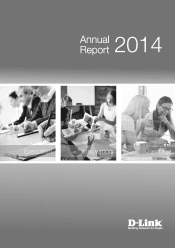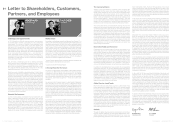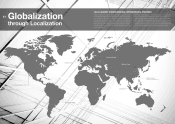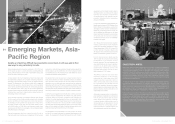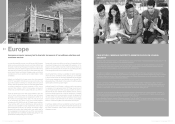D-Link 2014 Annual Report Download - page 5
Download and view the complete annual report
Please find page 5 of the 2014 D-Link annual report below. You can navigate through the pages in the report by either clicking on the pages listed below, or by using the keyword search tool below to find specific information within the annual report.
CASE STUDY: AIRTEL
Bharti Airtel Limited is a leading global tele
c
in 20 countries across Asia and Africa. Th
e
service providers globally by number of su
include 2G, 3G, and 4G wireless services,
m
speed DSL broadband, IPTV, DTH, and en
t
international long distance services to car
r
a new line of ADSL routers for their subsc
r
them the best possible solution.
The telecom sector in India is highly co
m
providers like Beetel and Binatone. The e
v
often ends with a reverse auction as co
m
other. Furthermore, telecom companies
g
customization in terms of firmware and s
p
these factors make it difficult for new playe
r
Differentiation was the key to D-Link’s s
u
product at a better price point, and effect
infrastructure and nationwide service
importantly – we were able to offer tim
e
customer’s unique needs. The case clearly
d
overarching global strategy: to think global
gg
providers, affording them a tremendous
amount of flexibility.
D-Link is also transitioning from FOB (Free On
Board) supply schemes to DDP (Delivery Duty
Paid) in Russia. For this purpose, a production
and logistics center has been constructed in
Ryazan. By producing products locally, we
will be allowed to participate in the state
import substitution program (a cornerstone
of Russia’s plan to improve economic
conditions) and thus secure our leadership
position in the region.
As in Russia, the macroeconomic situation
in Brazil, Latin America’s most important
market, also worsened significantly in 2014.
Growth slowed from 2.7% in 2013 to just 0.1%
in 2014. Still, the IT market in Brazil is the
7th largest in the world and enjoyed US$ 60
billion in investments, a growth of 6.7% YoY.
D-Link’s total revenue in Brazil grew by
15% YoY, and the company showed strong
performance in the telecom service
provider segment. The retail segment also
grew significantly as we strove to position
ourselves as an added value company,
supported by marketing services and
innovative new products such as our Wi-Fi
Baby Cameras and 11AC routers.
The DIR-615 router was one of the most
important products in the country,
responsible for D-Link’s share of the N300
market rising from nearly 0% in 2013 to
27% in 2014, second only to Link One. And
by re-positioning the DIR-505 and 503
primarily as “repeaters” (devices that repeat
wireless signals to extend range) rather than
personal routers, retailers were able to sell
substantially more of them.
Although emerging markets continued to
pose significant challenges to multinational
firms in 2014, D-Link was able to pursue
many unique local initiatives. Through
increased product differentiation and a
strong emphasis on “glocalization”, D-Link
drove demand for cutting edge, custom-
tailored
p
roducts in multi
p
le re
g
ions
,
all
DVMUNBDSPFDPOPNJDFOWJSPONFOU%-JOLXBTBCMFUPOE
B
SMZJO*OEJB
u
ttered in 2014. This turn
ctors, including falling oil
f
quantitative easing. Still,
ut Smart City project and
e
r networking industry is
r
ive the digital economy
middle class is triggering
c
ribers and broadband
f
or networking products
e
of business operations
e
also investing in network
s
iness opportunities for
c alliances have allowed
e
r network with a broader
v
e end-to-end solutions.
ctacular in India, with a
R
s.135.83 million in 2013
t shipment market share
ecosystem in India. We have witnessed steady business growth for
3G/4G products as the proliferation of Internet adoption fueled
by handheld devices like mobile phones and tablets has led to
increased demand for wireless products.
The government sector has also been a major business driver in
India, and D-Link has won many substantial contracts. In addition,
there has been strong demand for D-Link’s products from the
education sector, as more and more campuses seek to modernize
themselves with Wi-Fi and IP Camera surveillance solutions. Finally,
partnerships with major telecom companies such as Airtel, Tata, and
Hatchway have driven demand for D-Link’s ADSL routers and led to
some big victories for the company in a highly competitive market.
In 2014, Russia struggled economically due to falling oil prices,
western sanctions imposed over the Ukraine crisis, and currency
instability. Difficult economic conditions have changed the
direction of market development, but have not restricted it. With
brand presence in all the major Russian and CIS retail networks,
33 offices in Russia and 15 in the CIS, and 24-7 technical support
with after-sales service throughout the region, D-Link is still a major
player in these markets, with sales of Internet gateways, routers, and
n
g Markets, Asia-

